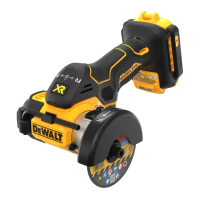11
ENGLISH
Adjusting the Guard Angle (Fig. E)
WARNING: Remove battery first. To reduce the risk of
injury when grinding, ALWAYS adjust the guard to
provide the best control and protection. ALWAYS wear
gloves to protect your hands when adjusting theguard.
You can adjust the angle of theguard.
1. Remove thebattery.
2. Grasp the guard
12
firmly and rotate to desiredangle.
The guard can rotate 30degrees, forward orbackward.
WARNING: To reduce the risk of injury, only use wheels
that are no greater than 3" (76mm) in diameter, have
an inner diameter of 3/8” (or 7/16” if using adapter
ring), and without cutting teeth. Thickness of wheel not
to exceed 0.09” (2.2mm). Never force a wheel onto the
machine or alter the size of the arborhole.
WARNING: Since accessories, other than those offered
by DeWALT, have not been tested with this product, use
of such accessories with this tool could be hazardous.
To reduce the risk of injury, only DeWALT recommended
accessories should be used with thisproduct.
1. Remove thebattery.
2. Lay unit on a firm surface, with the spindle
15
facingupward.
3. Hold spindle lock button
6
to keep the spindle
fromturning. Spindle threads are lefthand.
4. Using supplied 6mm wrench
13
, remove spindle
screw
19
, outer flange
18
, used wheel
20
if one
is installed and inner flange
16
. Spindle threads are
lefthand.
5. Slip the inner flange over the spindle.
NOTE: When intsalling 7/16" wheels, place the 7/16"
adaptor
17
over the innerflange.
6. Slip wheel over spindle. Make sure wheel goes over pilot
diameter of innerflange.
NOTE: When installing diamond*** wheels, always
match direction of rotation of the wheel to the desired
direction of rotation of the tool. Diamond*** wheels
will not cut effectively unless the direction marked on
the wheel matches the direction of rotation. Check the
setting of the forward/reverse/lock off button
5
to make
sure it matches the direction marked on thewheel.
7. Slip on outer flange with the flat side towards the
cut‑offwheel.
NOTE: The text "LOOSE TIGHTEN" will be visible when
installedcorrectly.
8. Start threading on spindle screw which will self align
outer flange. Make sure the wheel is fitted in the
correctorientation.
9. Engage spindle lock button and tighten spindle screw
with wrench. Do not over tighten spindlescrew.
10. Turn wheel by hand to ensure it is properly centered. The
wheel should not hit the shoe, guard or spindle screw.
The spindle screw and flanges should betight.
Installing Wheels (Fig. A, D, J)
WARNING: Burn Hazard. Sharp parts. ALWAYS wear
gloves when changing wheels. Wheels have sharp
edges or may get extremely hot during operation, and
may damage barehands.
Wheels
WARNING: To minimize the risk of eye injury, always
use eye protection. Carbide is a hard but brittle
material. Foreign objects in the workpiece such as wire
or nails can cause tips to crack or break. Mount the
wheel securely in proper direction of rotation before
using, and always use a clean, sharpwheel.
WARNING: To reduce the risk of injury, only use wheels
that are no greater than 3" (76mm) in diameter, have
an inner diameter of 3/8” (or 7/16” if using adapter
ring), and without cutting teeth. Thickness of wheel not
to exceed 0.09” (2.2mm). Never force a wheel onto the
machine or alter the size of the arborhole.
A dull wheel will cause slow inefficient cutting, overload the
motor, could cause excessive splintering, and could increase
the possibility of kickback. Please refer to the table below to
determine the correct wheel for yourapplication.
Wheel type Application
Diamond*** Multi‑Material
Wheel (DW8530)
Drywall, fiber cement, plastic, steel, non
ferrous materials
Bonded Abrasive Wheel
(DW8711)
Steel, stainless steel, non‑ferrous materials
Diamond*** Tile Wheel
(DW47350)
Ceramic Tile, Porcelain and Granite/Marble/
Stone
ASSEMBLY AND ADJUSTMENTS
WARNING: To reduce the risk of serious personal
injury, turn unit off and remove the battery pack
before making any adjustments or removing/
installing attachments or accessories. An
accidental start‑up can causeinjury.
Wall Mounting
Some DeWALT chargers are designed to be wall mountable
or to sit upright on a table or work surface. If wall mounting,
locate the charger within reach of an electrical outlet, and
away from a corner or other obstructions which may impede
air flow. Use the back of the charger as a template for the
location of the mounting screws on the wall. Mount the
charger securely using drywall screws (purchased separately)
at least 1” (25.4mm) long, with a screw head diameter of
0.28–0.35” (7–9mm), screwed into wood to an optimal
depth leaving approximately 7/32” (5.5 mm) of the screw
exposed. Align the slots on the back of the charger with the
exposed screws and fully engage them in theslots.
SAVE THESE INSTRUCTIONS FOR
FUTURE USE
may be removed from the exterior of the charger using
a cloth or soft non‑metallic brush. Do not use water or
any cleaningsolutions.

